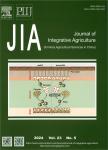Effect of the C.–1388 A>G polymorphism in chicken heat shock transcription factor 3 gene on heat tolerance
Effect of the C.–1388 A>G polymorphism in chicken heat shock transcription factor 3 gene on heat tolerance作者机构:College of Animal ScienceSouth China Agricultural University Key Laboary of Chicken GeneticsBreeding and ReproductionMinistry of Agriculture/South China Agricultural University Guangdong Enterprise Laboary of Healthy Animal Husbandry and Environment ControlSouth China Agricultural University Guangdong Wens Food Group Limited Company
出 版 物:《Journal of Integrative Agriculture》 (农业科学学报(英文版))
年 卷 期:2015年第14卷第9期
页 面:1808-1815页
核心收录:
学科分类:090603[农学-临床兽医学] 09[农学] 0906[农学-兽医学]
基 金:supported the National Key Technology R&D Program of China (2014BAD08B08) the Key Technology Research and Development Program of Guangdong Emerging Strategic Industries, China (2012A020800005)
主 题:chicken heat shock factor 3 dual luciferase report gene heat tolerance
摘 要:Heat stress is one of the main factors that inlfuence poultry production. Heat shock proteins (HSPs) are known to affect heat tolerance. The formation of HSPs is regulated by heat shock transcription factor 3 (HSF3) in chicken. A DNA pool was established for identifying single nucleotide polymorphisms (SNPs) of the chicken HSF3, and 13 SNPs were detected. The bioinformatic analysis showed that 8 SNPs had the capacity to alter the transcription activity of HSF3. The dual luciferase report gene assay showed that there was a signiifcant difference (PG (S1) and C.–1 388 AG (S4) sites at the 5′-untranslated region (UTR) of chicken HSF3. The elec-trophoretic mobility shift assay showed that the S4 site was a transcription binding factor. The analysis of the association of the S1 and S4 sites with heat tolerance index revealed that the S4 site was signiifcantly correlated with the CD3+T cel , corticosterone, and T3 levels in Lingshan chickens and with the heterophil/lymphocyte value in White Recessive Rock. These results showed that the S4 site at the 5′ UTR of chicken HSF3 might have an impact on heat tolerance in summer and could be used as a potential marker for the selection of chicken with heat tolerance in the future.



